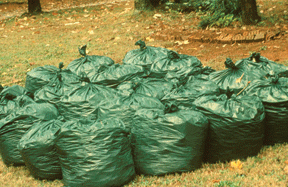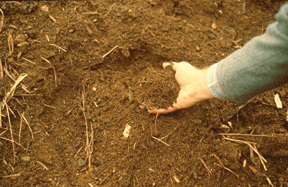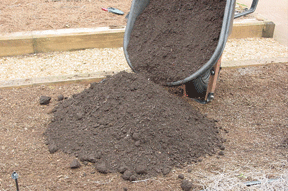Citizens throughout Georgia are recycling newspaper, cans, glass and plastic in an effort to divert these materials from the waste stream. Another important part of waste reduction involves recycling leaves, lawn clippings, and tree and shrub trimmings instead of placing them curbside for the county or municipality to pick up. These landscape riches from Mother Nature can be easily recycled and turned into nutrient-rich organic matter right in your backyard through a process called composting.
This publication answers some commonly asked questions about composting.
What is compost?
Compost is fine-textured humus, which is an end product from the natural decomposition of plants and plant products under controlled conditions.
What materials can be composted?

Almost any organic plant material can be used for composting, including grass clippings, leaves, twigs, chipped brush and old vegetable or flowering plants. Vegetable peelings and coffee grounds can also be composted.
Are there any materials that should NOT be composted?
Avoid adding meat scraps, bones or dairy products because they may attract unwanted animals. Also avoid adding pet wastes because they may harbor parasites that can infect humans. Seeds and tubers of some plants, like morning glory, nutsedge and Florida betony, may not be killed by the composting process and should be left out of the mix.
Does composting smell bad?
Compost piles won't smell bad as long as there is good ventilation, the mixture contains both browns (leaves, straw or chipped brush) and greens (green plant parts and vegetable peelings), and it does not stay too wet. When the right mixture is present and the composting process is working properly, odor-causing bacteria will not be present within the pile. The microorganisms and insects feeding on the organic matter need air to break it down. A sewage-like odor coming from the pile indicates that either there is insufficient aeration within the pile, that the pile is too wet, or that the ratio of browns to greens is wrong (ideally, 4:1).
Do I have to build a frame to hold the compost?

Decomposition works best if a simple structure holds the materials together. Any type of structure can be used, including welded wire, fencing, pallets, blocks or commercially available bins designed especially for making compost. The bin should allow good air circulation throughout the organic materials, and the bottom should be open to the ground to allow good drainage.
Where should I place the compost bin?
Locate the compost bin in an out-of-the-way place in the landscape, in full sun and on a well-drained site close to a water source.
How big can I make the pile?
For sufficient heating and decomposition, the pile needs to be at least 3 feet high and 3 feet wide. Piles larger than 5 feet high are difficult to manage and may emit odors if they are not sufficiently aerated.
How do I construct the pile?
For best decomposition, it's best to mix a variety of materials, both browns and greens. The ideal ratio is four parts brown material (leaves, chipped wood, twigs) to one part green material (green trimmings, discarded annuals, old vegetable plants, vegetable peelings). Piles are usually layered with whatever organic material is available at a given time of year. During the fall months, for instance, leaves (browns) are plentiful. However, it is best to fill the bin only one-fourth full with leaves and wait until you accumulate a few green materials to add to the pile before adding more leaves. Fall leaves can be held in plastic bags throughout the fall and winter months for layering in the pile whenever browns are needed. When adding woody material, it's best to chip or shred it into small pieces so it will break down more quickly.
When the bin is full, add a few shovelfuls of livestock manure or previously made compost to the top to inoculate the material with microorganisms, insects and earthworms and start the decomposition process. A cup of ammonium nitrate fertilizer added to the top of the materials will provide energy for the microorganisms and will speed up the composting process, but it is not required for decomposition to occur.
How do I care for the pile?

Keep the pile moist, but not too wet. It is too wet if water can be squeezed from a handful of organic material taken from the center of the pile several hours after rain or irrigation.
To speed up the decomposition process, reduce moisture content and prevent odors, mix the pile once a month using a shovel or spading fork. The more often the pile is turned, the more quickly the organic materials will decompose.
Some gardeners prefer a more passive approach and do not turn the pile at all. That's perfectly acceptable, but the composting process will likely occur more slowly.
Can I keep adding materials to the pile?
A compost pile can be perpetually managed. It will shrink as decomposition occurs, and new materials can be added to the top.
What causes decomposition?
The compost pile is a microbial farm, teeming with bacteria, fungi, insects and earthworms. These compost critters feed on the organic matter, breaking it down into fine-textured humus. When the decomposition process is in full swing, energy generated by the micro-organisms will cause the pile to heat up. You may see steam rising from the pile on a cool morning or when turning and aerating the material. This indicates the composting process is working well and the microorganisms are doing their job. Earthworms do not like the high temperatures in the center of the pile, so they usually work in the upper level of the organic materials and in the finished compost that has cooled down at the bottom of the pile.
Does compost have a nutrient value?
Yes. Compost slowly releases a small amount of plant nutrients, but it won't substitute for fertilizer, particularly for nutrient-demanding plants like annual flowers and vegetables. Gardeners often need to supplement the compost with a granulated fertilizer, like 10-10-10, or an organic fertilizer, like composted animal manure.
When is compost ready to use?
Compost is ready when it looks like rich, crumbly earth and the original plant material is no longer recognizable. Each time the pile is turned, some ready-to-use compost should be available for harvesting from the bottom of the pile. Some gardeners screen their compost by sifting it through a mesh screen. Any organic materials that have not fully decomposed are added back to the pile to continue decomposing.
How can I use compost?
Compost can be used in the landscape and vegetable garden. Before planting, place 3 inches of compost on the soil surface and incorporate it to a 12-inch depth. Compost also can be used as mulch on the soil surface. Avoid using pure compost for containerized plants because its high levels of organic acids and salts may damage roots. It also tends to dry out more quickly than growing media containing peat moss, vermiculite and other water-absorbing substances. It's best to use prepared growing mixes obtained from garden centers for containerized plants.
For additional information, see Circular 816, Composting and Mulching.
Acknowledgement is made to Wayne McLaurin, retired Extension horticulturist, for preparing the original manuscript for this publication.
Status and Revision History
Published on Dec 16, 2009
Published with Full Review on Feb 10, 2014
Published with Full Review on Mar 28, 2017
Published with Full Review on Jul 07, 2022


























































